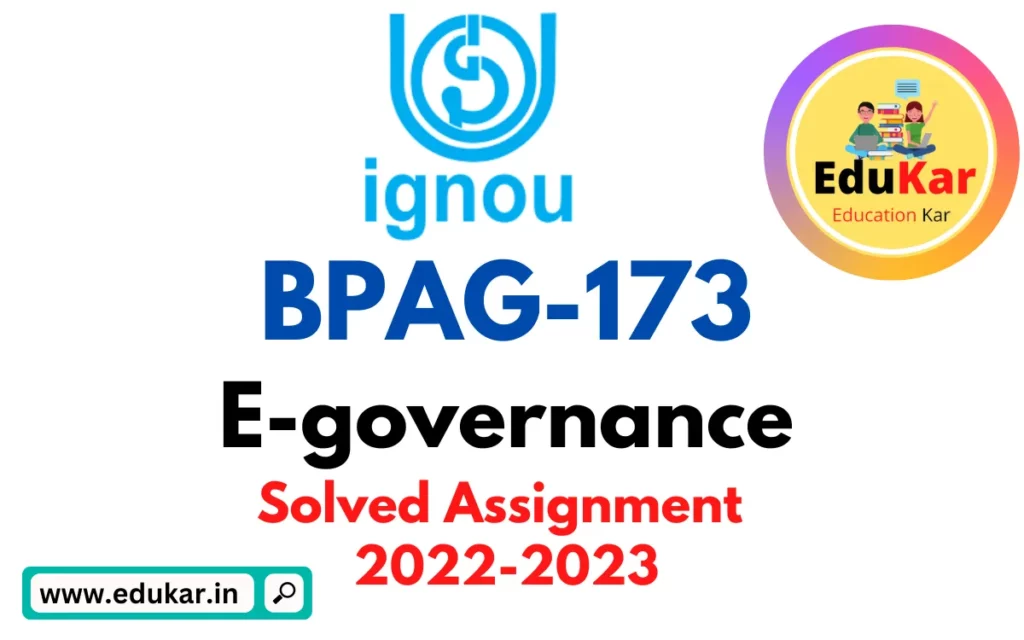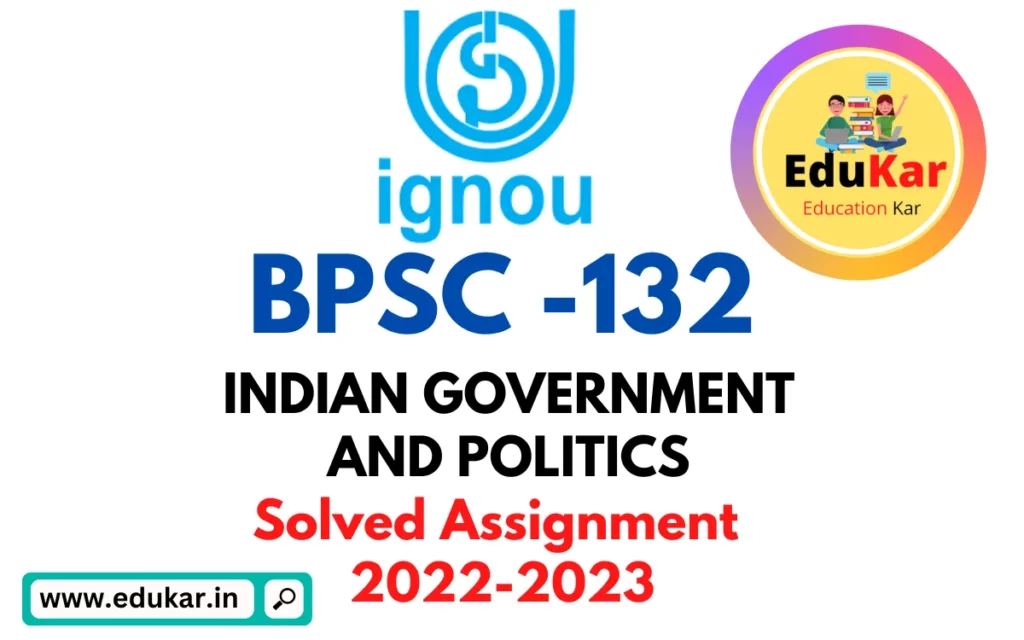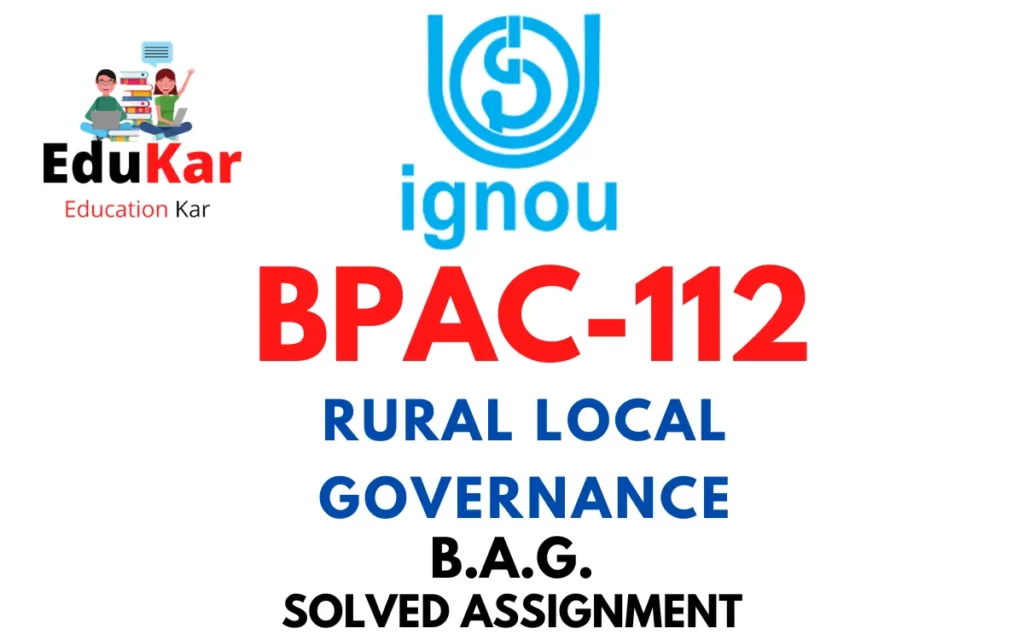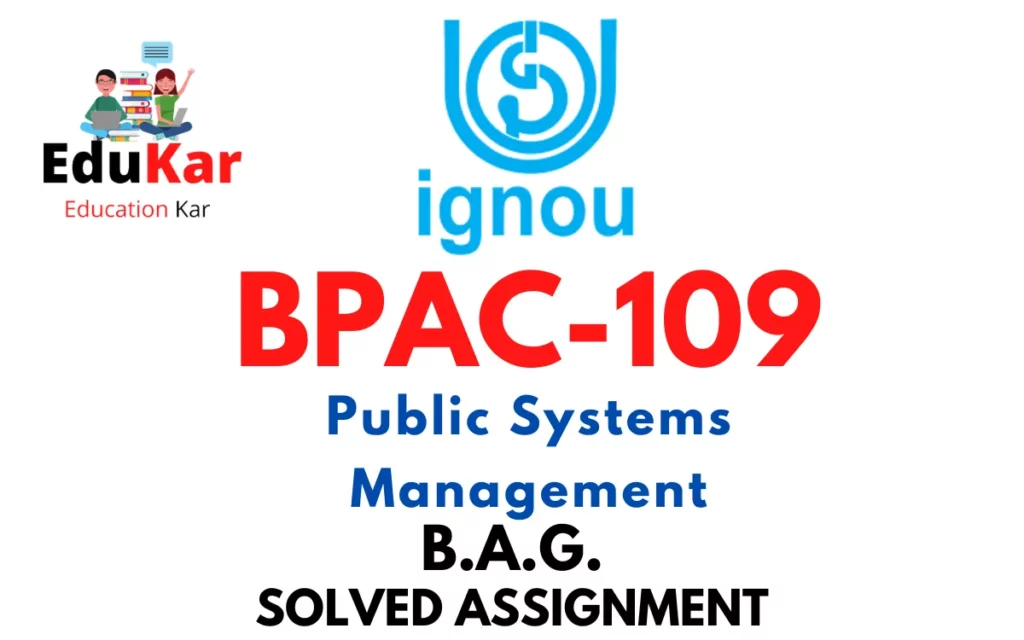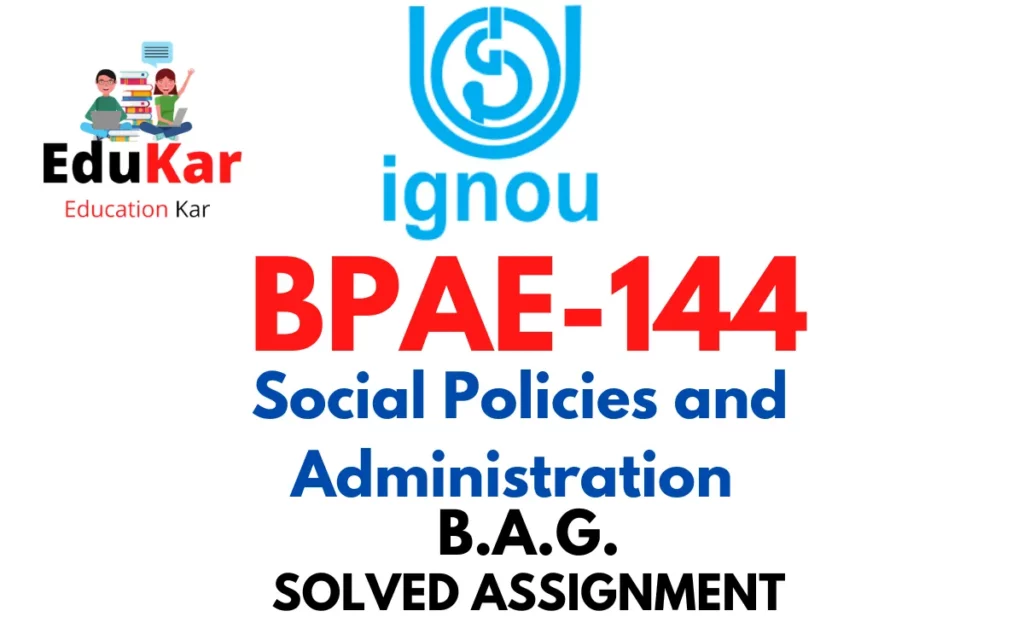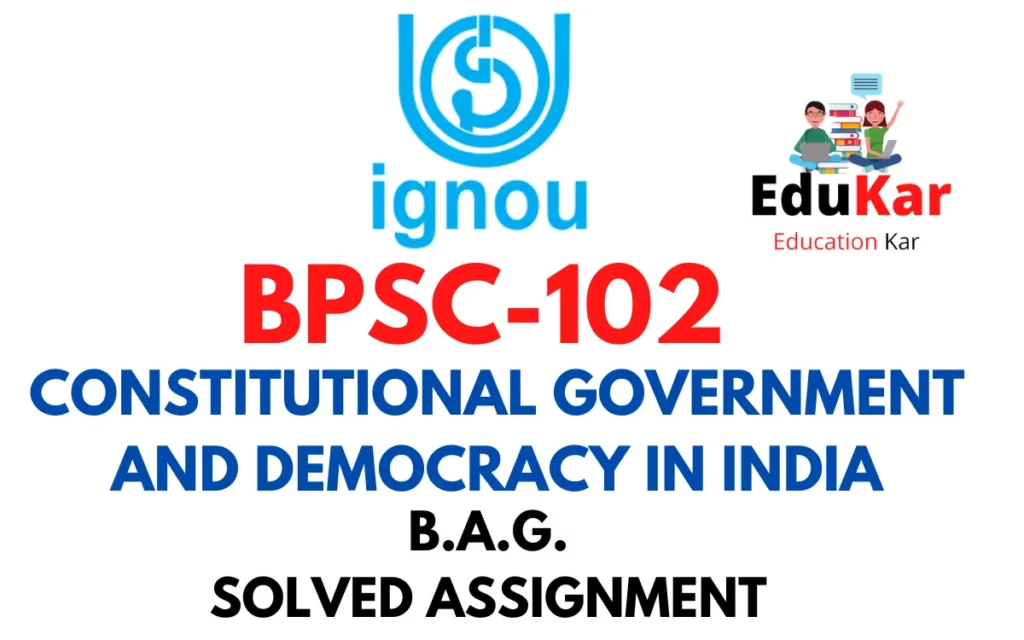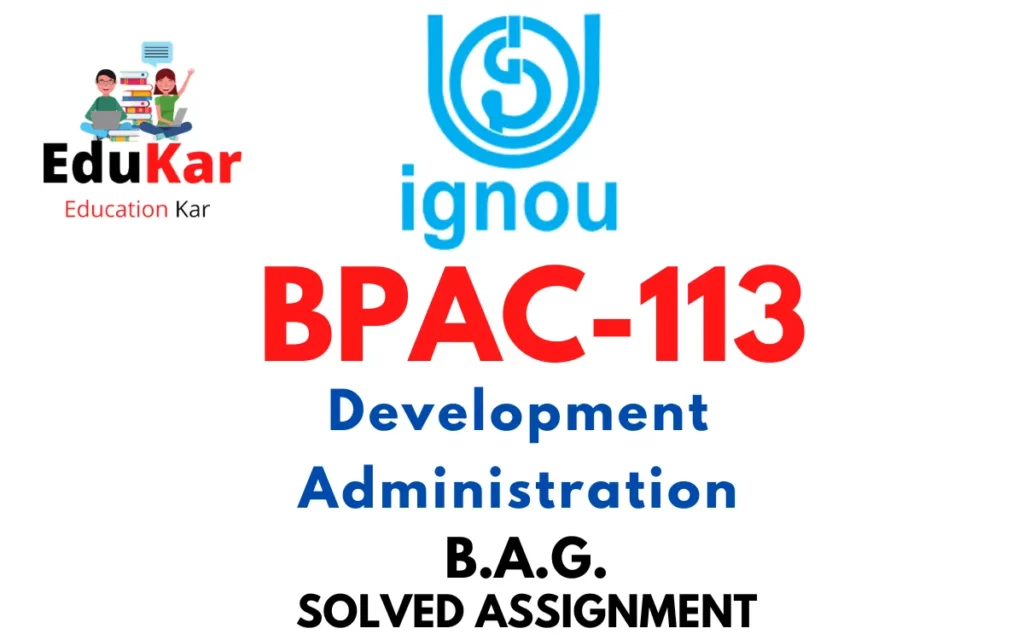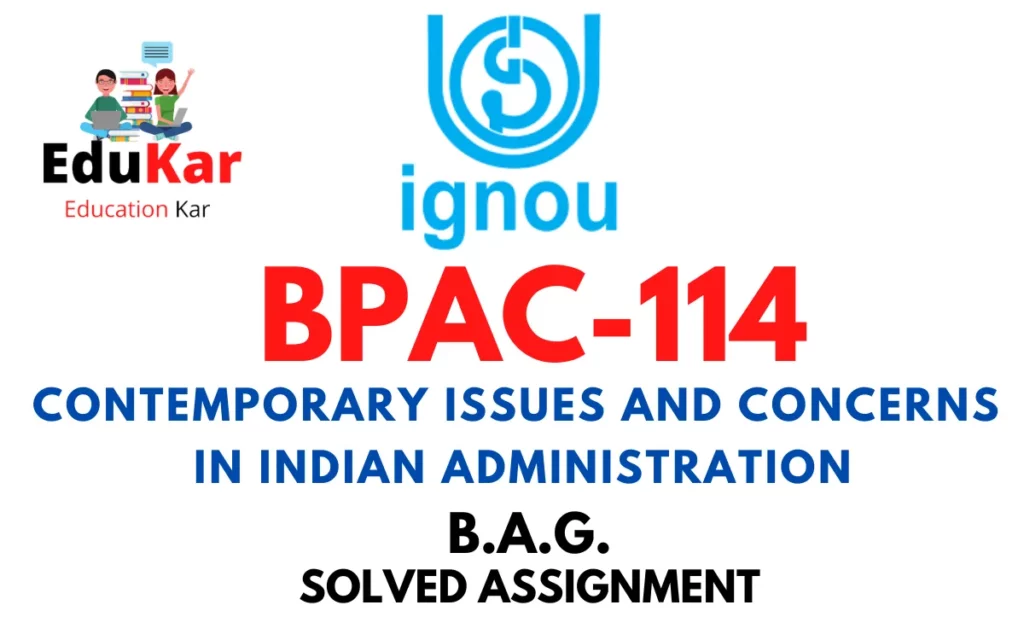Contents
- 1 Assignment A
- 2 Answer the following questions in about 500 words each.
- 3 1. ‘‘The RTI Act is a path-breaking legislation that signals the march from darkness of secrecy to dawn of transparency’’. Comment.
- 4 2. Examine the problems and gaps, which are responsible for lack of effective implementation of the RTI Act, 2005.
- 5 Assignment B
- 6 Answer the following questions in about 250 words each.
- 7 3. Write a note on the Central Information Commission.
- 8 4. Discuss the major challenges before the public authorities
- 9 5. “Social Audit is a powerful tool, which is associated with accountability and promotes the RTI”. Examine.
- 10 Assignment C
- 11 Answer the following questions in about 100 words each.
- 12 6. Enumerate the various initiatives for generating public awareness regarding RTI.
- 13 7. Write a note on the Project Sarathi.
- 14 8. Examine the role and access of Media to Court Proceedings.
- 15 9. Highlight the significance of Commonwealth Human Rights initiative campaign for RTI.
- 16 10. Discuss the role of Jannakari – A facilitation centre to strengthen the RTI.
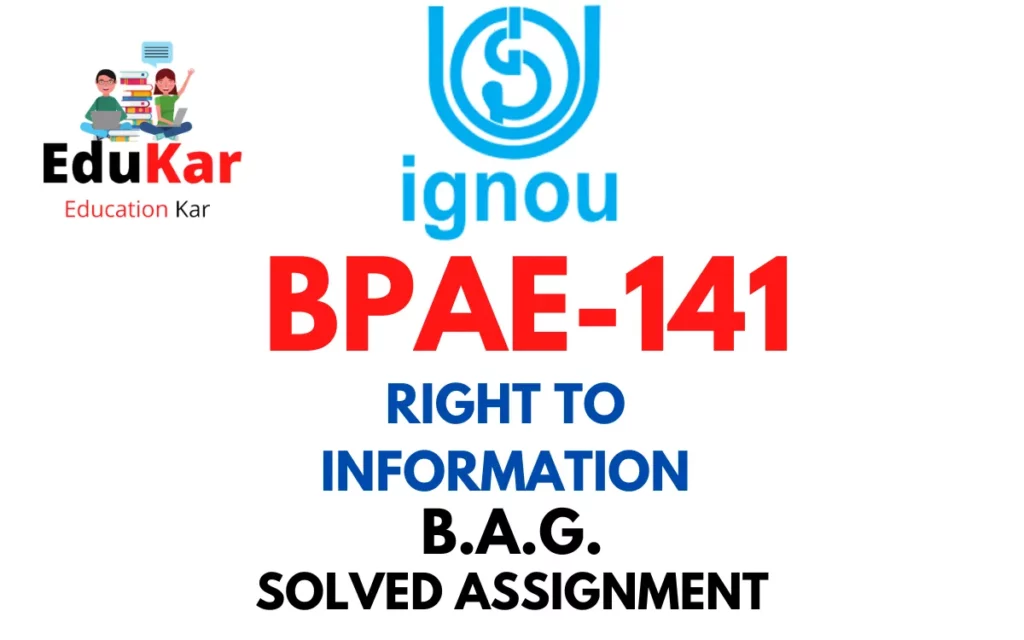
| Title | BPAE-141: IGNOU BAG Solved Assignment 2022-2023 |
| University | IGNOU |
| Degree | Bachelor Degree Programme |
| Course Code | BPAE-141 |
| Course Name | RIGHT TO INFORMATION |
| Programme Name | Bachelor of Arts (General) |
| Programme Code | BAG |
| Total Marks | 100 |
| Year | 2022-2023 |
| Language | English |
| Assignment Code | ASST /TMA / July 2022 & January 2023 |
| Assignment PDF | Click Here |
| Last Date for Submission of Assignment: | For June Examination: 31st April For December Examination: 30th September |
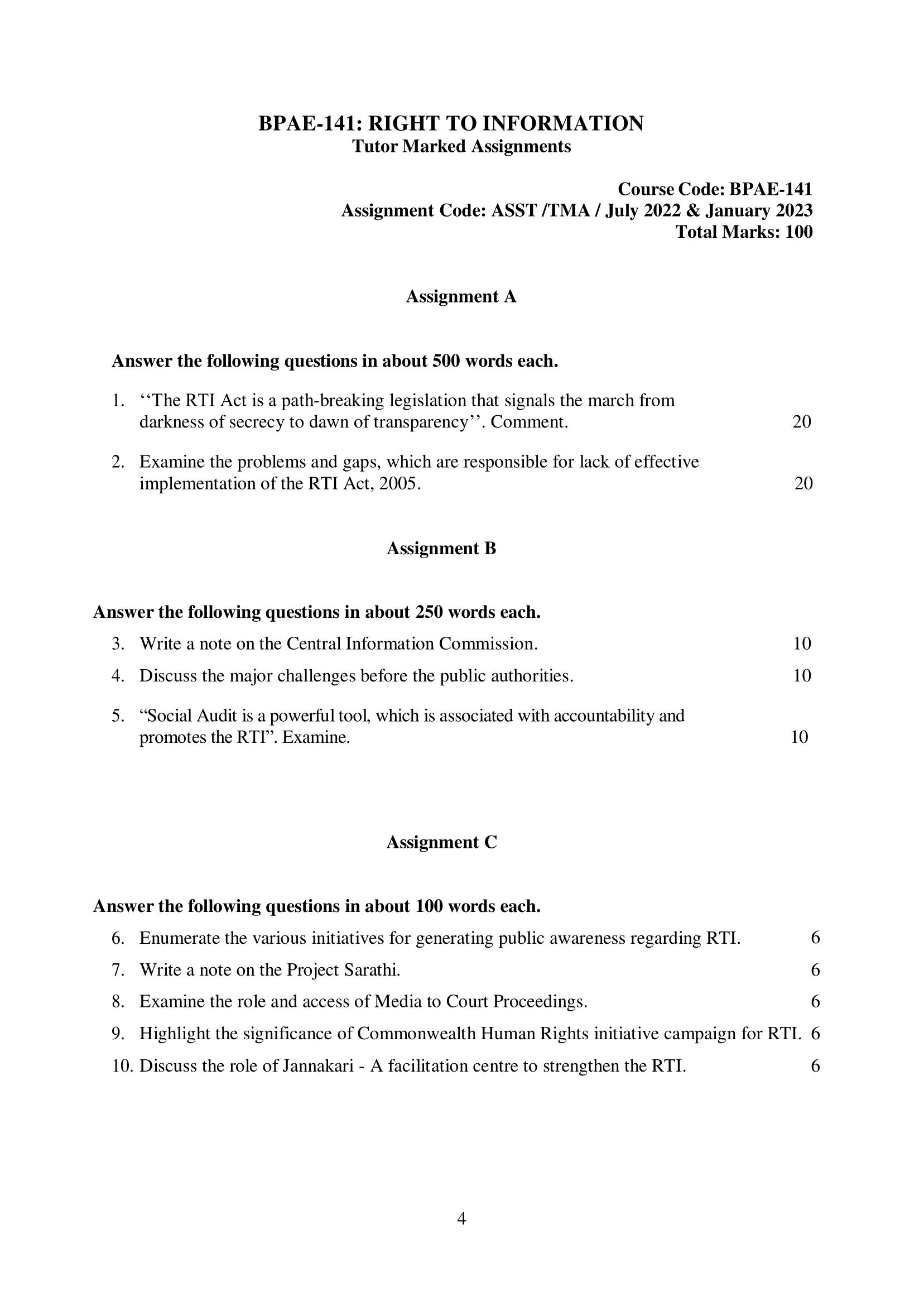
Assignment A
Answer the following questions in about 500 words each.
1. ‘‘The RTI Act is a path-breaking legislation that signals the march from darkness of secrecy to dawn of transparency’’. Comment.
Ans: The Right to Information (RTI) Act is a path-breaking legislation that was enacted by the Indian Parliament in 2005. It empowers citizens to demand and access information from government authorities, thereby ensuring transparency and accountability in the functioning of government bodies. The Act has been instrumental in promoting the principles of democracy and good governance in India.
The RTI Act has been a significant milestone in the history of India’s struggle for transparency and accountability. The Act has given a voice to the common man, enabling them to seek information and hold the government accountable for their actions. The RTI Act has also been instrumental in checking corruption and promoting good governance by ensuring that government authorities are transparent and accountable in their functioning.
The RTI Act has been successful in creating a culture of transparency in the country. It has made the government more accountable to the people, and has also helped to build trust between the government and citizens. The Act has also helped in the prevention of corruption, as public servants are now more cautious and accountable for their actions.
The RTI Act has also helped to empower citizens, particularly those from marginalized sections of society. By giving them the right to access information, the Act has enabled them to demand their rights and hold the government accountable for their actions. The Act has also been instrumental in creating a more informed citizenry, which is essential for the growth of any democratic society.
In conclusion, the RTI Act has been a path-breaking legislation that has brought about a significant change in the functioning of the government. It has been instrumental in promoting transparency, accountability, and good governance in the country. The Act has also been successful in empowering citizens and creating a more informed citizenry. The RTI Act is a milestone in India’s journey towards a more transparent and accountable government, and it signals the march from darkness of secrecy to dawn of transparency.
2. Examine the problems and gaps, which are responsible for lack of effective implementation of the RTI Act, 2005.
Ans: The Right to Information (RTI) Act, 2005 is a powerful tool for ensuring transparency and accountability in the functioning of the government in India. However, despite the potential benefits of the Act, there are several challenges and gaps that prevent its effective implementation. In this essay, we will examine some of the key problems and gaps that are responsible for the lack of effective implementation of the RTI Act.
- Lack of awareness and education: One of the major reasons for the lack of effective implementation of the RTI Act is the lack of awareness and education among the general public. Many people are not aware of their rights under the Act and do not know how to use it to obtain information. There is a need for more awareness campaigns and education programs to inform citizens about their rights under the Act and how to effectively use it to obtain information.
- Lack of infrastructure: Another major problem with the implementation of the RTI Act is the lack of infrastructure and resources to implement the Act effectively. This includes the lack of trained staff, adequate funding, and technological infrastructure to handle the volume of requests received. Many government bodies lack the resources to handle the large number of RTI requests they receive, leading to delays and backlogs.
- Resistance from government officials: There is a lack of commitment and cooperation from government officials in implementing the RTI Act. Some officials are reluctant to provide information, and in some cases, they intentionally withhold information or provide incomplete information. The lack of penalties for officials who do not comply with the Act has also contributed to this problem.
- Lack of transparency in political parties: The RTI Act does not currently apply to political parties, which are not considered public authorities under the Act. This means that political parties are not required to disclose information about their funding, expenses, or decision-making processes. This lack of transparency can have a significant impact on the functioning of democracy and good governance.
- Lack of accountability and monitoring: There is a lack of accountability and monitoring of the implementation of the RTI Act. There is no effective mechanism to hold officials accountable for delays or non-compliance with the Act. This lack of accountability has resulted in a lack of transparency and an increase in corruption in the functioning of government bodies.
Assignment B
Answer the following questions in about 250 words each.
3. Write a note on the Central Information Commission.
Ans: The Central Information Commission (CIC) is an independent statutory body established under the Right to Information (RTI) Act, 2005. It is responsible for promoting transparency and accountability in the functioning of the government by implementing the RTI Act. The CIC is based in New Delhi, and its jurisdiction extends to the whole of India.
The CIC has the power to receive complaints and appeals from individuals who have been denied access to information under the RTI Act. It also has the authority to order public authorities to disclose information that has been withheld, impose penalties on officials who violate the RTI Act, and promote public awareness of the RTI Act.
The CIC is headed by the Chief Information Commissioner (CIC), who is appointed by the President of India. The CIC is assisted by Information Commissioners, who are also appointed by the President of India. The CIC and Information Commissioners serve a term of five years or until they attain the age of 65, whichever is earlier.
The CIC has played a crucial role in promoting transparency and accountability in the functioning of the government. It has dealt with a large number of cases related to the RTI Act, and its decisions have set important precedents for the disclosure of information by public authorities. The CIC has also taken steps to promote awareness of the RTI Act, such as by conducting workshops and training programs for government officials and the public.
Ans: Public authorities are government entities responsible for providing services and implementing policies that benefit the public. They are expected to operate in a transparent, efficient, and accountable manner to ensure the effective delivery of public goods and services. However, several challenges confront public authorities, which impede their ability to perform their duties efficiently. In this section, we discuss some of the major challenges before public authorities.
- Corruption: Corruption is a major challenge before public authorities. It involves the misuse of public resources for personal gain, which not only undermines public confidence in the government but also affects the effective delivery of public services.
- Bureaucratic inefficiency: Bureaucratic inefficiency is another major challenge before public authorities. It refers to the slow and cumbersome processes of decision-making and implementation that often delay or obstruct the effective delivery of public services.
- Lack of transparency: Lack of transparency is another major challenge before public authorities. It involves the unwillingness of public authorities to disclose information to the public, which leads to a lack of accountability and transparency in government operations.
- Limited resources: Limited resources are a major challenge before public authorities, particularly in developing countries. Public authorities often face budgetary constraints that limit their ability to provide adequate public services.
- Political interference: Political interference is another major challenge before public authorities. It refers to the influence of political actors on the functioning of public authorities, which can undermine the autonomy and impartiality of public institutions.
- Public discontent: Public discontent is a challenge before public authorities, particularly when citizens feel that their needs are not being adequately addressed. Public discontent can lead to protests and social unrest, which can further complicate the functioning of public authorities.
5. “Social Audit is a powerful tool, which is associated with accountability and promotes the RTI”. Examine.
Ans: Social Audit is a process by which the public can assess the performance and accountability of public institutions, including government bodies and NGOs. It is a powerful tool for promoting transparency, accountability, and the Right to Information (RTI). In this section, we will examine how social audit is associated with accountability and promotes the RTI.
Social Audit is an important accountability tool that allows the public to participate in the monitoring and evaluation of public institutions. It provides an opportunity for citizens to access information on the performance and functioning of public institutions, including their budgets, policies, and programs. Social audits can be used to assess the impact of public programs and services, identify areas of inefficiency and corruption, and recommend improvements.
Social audit promotes the RTI by facilitating the access to information for citizens. The RTI Act, 2005, provides citizens with the right to access information held by public authorities. Social audit processes provide an opportunity for citizens to exercise their RTI rights by making it easier for them to access information on the performance of public institutions. By encouraging transparency and accountability, social audits help to build public trust in government institutions and promote citizens’ participation in the decision-making process.
The social audit process involves the active involvement of citizens and civil society organizations. This promotes citizen engagement in the democratic process and ensures that public institutions are responsive to the needs and concerns of the public. By involving citizens in the social audit process, the public is empowered to hold public institutions accountable for their performance.
Assignment C
Answer the following questions in about 100 words each.
6. Enumerate the various initiatives for generating public awareness regarding RTI.
Ans: There have been several initiatives by the government, civil society organizations, and individuals to generate public awareness regarding the Right to Information (RTI) Act in India. Some of these initiatives include:
- Conducting workshops and training programs to educate citizens about the RTI Act and how to file RTI requests.
- Developing online platforms and resources to provide information about the RTI Act and help citizens file RTI requests.
- Launching public awareness campaigns through media channels, including television, radio, and social media.
- Holding RTI clinics and public meetings to promote the use of the RTI Act and provide information to citizens.
- Encouraging the use of the RTI Act through awards and recognition programs for citizens and organizations that have used the Act effectively.
These initiatives have been crucial in promoting awareness of the RTI Act and ensuring that citizens are aware of their rights to access information from government authorities.
7. Write a note on the Project Sarathi.
Ans: Project Sarathi is an initiative by the Ministry of Road Transport and Highways (MoRTH) in India aimed at digitizing the process of issuing driving licenses and vehicle registration certificates. The project was launched in 2018 with the objective of improving the efficiency and transparency of the licensing and registration process and reducing corruption.
Under Project Sarathi, all Regional Transport Offices (RTOs) in the country are connected to a central database, which allows for the seamless exchange of information and data. The system is designed to ensure that all licensing and registration procedures are handled online, which eliminates the need for manual paperwork and reduces the possibility of corruption.
One of the key features of Project Sarathi is the integration of biometric technology in the licensing process, which ensures that each license is unique and cannot be duplicated. The system also includes a real-time monitoring and surveillance mechanism to ensure that all procedures are being carried out in a transparent and efficient manner.
The project has been successful in reducing the time taken to issue driving licenses and vehicle registration certificates, which has helped in streamlining the process and reducing the burden on RTOs. The system is also accessible to citizens through a web-based portal, which enables them to track the status of their license or registration application and provides easy access to information.
8. Examine the role and access of Media to Court Proceedings.
Ans: The role of the media in court proceedings is to provide information and report on court proceedings to the public. The media plays a critical role in ensuring that court proceedings are transparent and accountable, and it provides a platform for the public to be informed of the judicial process. In this section, we will examine the role and access of the media to court proceedings.
The media’s role in court proceedings is to provide accurate, reliable, and timely information to the public about the judicial process. This includes providing coverage of court hearings, judgments, and legal arguments. The media also plays a critical role in ensuring that court proceedings are transparent and accountable, and it provides a platform for the public to understand the legal process.
In many countries, the media is granted access to court proceedings, subject to certain restrictions and guidelines. The media’s access to court proceedings is essential for promoting transparency and accountability in the judicial process, and it enables the public to be informed about the legal process.
However, the access of the media to court proceedings is subject to certain restrictions and guidelines, which may vary from country to country. The restrictions are designed to protect the interests of the parties involved in the legal process, including the accused, the victims, and the witnesses. The restrictions may include the prohibition of broadcasting or photographing certain aspects of the proceedings, such as the jury or the witness box.
The media’s access to court proceedings can also be limited by the court itself, based on the principle of open justice. The principle of open justice requires that court proceedings be conducted in public and that the media is granted access to court proceedings. However, there may be exceptions to this principle, such as in cases involving national security or sensitive information.
9. Highlight the significance of Commonwealth Human Rights initiative campaign for RTI.
Ans: The Commonwealth Human Rights Initiative (CHRI) is a non-governmental organization that promotes and protects human rights in the Commonwealth countries. One of the significant campaigns of CHRI is promoting the implementation of the Right to Information (RTI) in Commonwealth countries. In this section, we will highlight the significance of the CHRI campaign for RTI.
The CHRI campaign for RTI is significant because it seeks to promote transparency, accountability, and good governance in Commonwealth countries. The RTI is a fundamental human right that ensures citizens’ access to information held by public authorities, which is essential for promoting transparency and accountability. The campaign seeks to encourage Commonwealth countries to adopt and implement robust RTI laws that will enable citizens to hold public authorities accountable for their actions and decisions.
The CHRI campaign for RTI is significant because it seeks to promote citizen participation in the decision-making process. The RTI laws promote citizen engagement by providing them with the information they need to participate in the democratic process actively. By enabling citizens to access information held by public authorities, the RTI laws empower citizens to participate in the decision-making process and hold public authorities accountable.
The CHRI campaign for RTI is significant because it seeks to promote the rule of law and democracy in Commonwealth countries. The RTI laws are essential for promoting the rule of law because they ensure that public authorities are accountable for their actions and decisions. By promoting accountability, the RTI laws contribute to the development of a democratic culture, which is essential for the promotion and protection of human rights.
10. Discuss the role of Jannakari – A facilitation centre to strengthen the RTI.
Ans: Jannakari is a facilitation center set up by the Odisha government in 2017 to strengthen the implementation of the Right to Information (RTI) Act. The primary objective of Jannakari is to facilitate access to information for citizens and to promote transparency and accountability in government operations. The center provides a range of services to the public, including assistance in filing RTI applications, tracking the status of applications, and providing access to information. Jannakari also conducts training programs for government officials to raise awareness about the RTI Act and its implementation. The establishment of Jannakari has helped to promote transparency and accountability in government operations and has empowered citizens by making it easier for them to access information held by public authorities.
How to Download BPAE-141 Solved Assignment?
You can download it from the www.edukar.in, they have a big database for all the IGNOU solved assignments.
Is the BPAE-141 Solved Assignment Free?
Yes this is absolutely free to download the solved assignment from www.edukar.in
What is the last submission date for BPAE-141 Solved Assignment?
For June Examination: 31st April, For December Examination: 30th October

